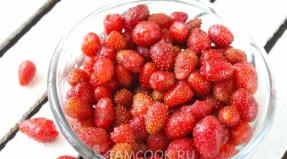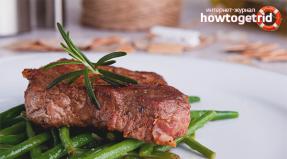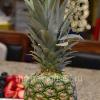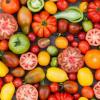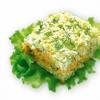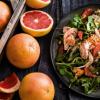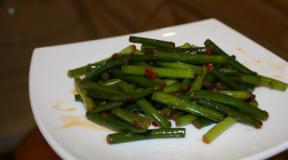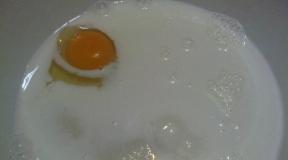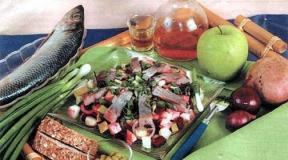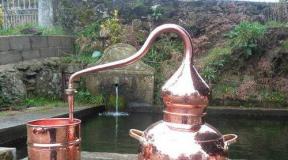Miracle (Dagestan flatbread). Cooking
1. Add soda to kefir at room temperature, mix and leave for 5 minutes.
2. In a deep bowl, mix 1 cup of flour, salt and kefir. Gradually adding the remaining flour, knead an elastic, non-sticky dough without lumps. Cover the finished dough with a napkin and leave alone until the filling is prepared.
3. Boil the potatoes in their uniforms until cooked, then cool slightly (the tuber can be picked up), peeled and mashed into a dry puree (do not add oil or fat).
4. Grate the cheese on the smallest grater.
5. Combine cheese with potatoes, add sour cream and chopped herbs (optional), lightly salt. Stir until a homogeneous mass is obtained.
6. Divide the dough into 8 equal pieces, from which roll the balls.
7. Roll the balls into thin cakes, put the potato and cheese filling inside in the center of the cakes, pinch on top to make balls again.

8. Gently, trying not to squeeze out the filling, roll the balls to cakes.
 Cakes before frying
Cakes before frying 9. Heat up a dry, heavy-bottomed skillet. Fry each tortilla alternately on both sides (without oil).

10. Put the finished miracle with potatoes on a plate, lightly grease with butter. Cover to keep the tortillas warm and soft for a long time. Serve with sour cream.
Among the various peoples of the Caucasus, incl. and Dagestan, have their own characteristics or family variations in the preparation of dough and filling for a miracle, as well as options for shaping this pie. Chudu is prepared both as an independent dish in the daily menu, and as an addition to other dishes on the festive table.
For a meat option, take minced lamb, beef or the meat that is available or preferred, add spices to it that give the dish Caucasian notes - these are hot and fragrant peppers, thyme, basil or suneli hops, etc.
I had a fragrant salt-seasoning "Georgian fragrant" with a very pleasant colorful composition, so I added it to the minced meat.
Knead the dough by hand or with the help of kitchen appliances, fresh, similar to dumplings. Miracle can be fried in a pan or baked in the oven. I prefer the option of baking in the oven.
Prepare the ingredients according to the list
First, prepare the dough so that while you work on the filling, it rests and reaches the desired state. Combine eggs with water and salt, stir lightly.

Add flour and knead elastic dense dough.

Cover the dough from drying out and leave it to "ripen".

Prepare minced meat, pour broth and vinegar into it, add salt and spices

and knead well until viscous.

Take a piece about the size of a fist from the dough and roll it thinly into a circle. Then you need to lay out and spread the minced meat on half the dough.

Cover the filling with the second half of the dough and you will get a workpiece in the shape of a semicircle or crescent. Connect the edges tightly, cut off the excess dough with a knife.

Lay the miracle blanks on a baking sheet and bake until cooked in a preheated oven at 200 degrees for about 20-25 minutes. Lubricate the finished hot miracle with meat with butter and lay on top of each other.

Miracle with meat ready!

Bon Appetit!
Today, I want to tell you something about Dagestan cuisine. Considering that Dagestan is a unique multinational republic in which dozens of ethnic groups live, the concept of "Dagestan cuisine" is somewhat surprising.
The cuisine of each of the nations is somewhat similar, but it is also original. The dishes that exist in each individual region of Dagestan carry a special flavor. But there are dishes common everywhere. These are considered "kurze", "miracle", "khinkal".
This post will be dedicated to the famous Dagestan miracle cakes (with an emphasis on the last sound U). Chudu are of two types - thin and thick. Thin ones are always fresh, made with various fillings and baked in a pan. And the thick so-called "Dargin miracles" can be both unleavened and yeast, baked in the oven, look like a pie and usually have one composition (meat, potatoes, plus cabbage if desired).
Thin wonders look like this.
Honestly, they are much tastier than they look in my photo :)
How to make them. I am writing a recipe that I use myself.
DOUGH
Everything is done by eye. No, no, this does not mean that we need to call the household and try to fall asleep and pour the ingredients we need into their eyes (black and non-black) ... because they still have to eat our culinary product. In general, we will take pity on the household, we will do it on our own :)
Alternatively, you can make dough on kefir. We replace water with kefir, the rest is the same. Some people add a dash of soda.
We take water, preferably filtered or boiled. We add a little salt to it, add vegetable oil (about 1 tablespoon of oil per glass of water). You can do it without it (in a severe crisis), but I still like it more, because our end result, the cakes, are softer. Now add the sifted flour. I can’t say how much flour is needed, not because I don’t want to, but because 1) I have never measured it, 2) different types of flour require a different amount. We add flour, focusing on our innate sense of taste and remarkable culinary abilities. You should get a soft dough.
After that, we leave the dough for proofing, for about 15-20 minutes and start working on the filling.
The filling can be the most diverse
Option 1 with onions: green onion with egg
my green onion, cut it (not small, not large), put it in a frying pan and start frying. After the onion releases juice, add a little vegetable oil. Slightly fry it over medium heat (4-5 minutes), periodically placing and salting. Then break the egg into a plate, beat it a little with a fork and add to the onion. I put 1 egg on a standard market bunch of onions. You can put 1 egg on 2 bunches of onions, this is not so important and is adjusted to taste. We stir our stuffing until the egg seizes. After that, turn off the burner. Transfer the stuffing to a plate and set aside. Particularly hungry and impatient may not cool.
Option 2 with greens: a similar option, only instead of or together with onions, greens are used - nettle and halta.
I met the weed khaltu only in Dagestan, maybe it is, of course, and somewhere else, I don’t know this. It grows on mountain slopes like a weed. Resourceful people collect it and sell it at local bazaars. It does not have a particularly pronounced taste. The coat looks like this.
Option 3 meat: meat, onions and greens
We take minced meat, add finely chopped onions, a little water and greens (usually cilantro). Greens, in general, are not required. But we like it better. And of course, do not forget to salt :). As a variation, in the summer I add grated tomato to the filling for more juiciness.
I used to make from raw meat, according to the technology it should be so. But due to the fact that my friend was recently diagnosed with an echinococcal cyst in the liver, she began to grow older than raw meat.
Therefore, for those who are as cowardly as I am, meat can be subjected to heat treatment. For example, boil a piece of meat and then run it through a meat grinder. Or fry already prepared minced meat.
Option 4 cottage cheese: cottage cheese, salt, egg, potatoes, optionally green onions
Cottage cheese is rubbed through a grater or simply kneaded, salted, and a raw egg is added. You can add some hot mashed potatoes if you like. Or chopped green onions.
Option 5 pumpkin: pumpkin, salt, walnuts, onions (or fried - onions with carrots)
or pumpkin, onion, salt, sugar, red pepper, oil
a) rub the pumpkin on a grater, stand a little and drain the juice (this way you can make a pumpkin if the miracle is baked in the oven)
b) the pumpkin is pre-boiled, then chopped
c) the pumpkin is baked in the oven and chopped
d) stew the grated pumpkin in a pan
Next, chopped raw or fried onions (or fried onions with carrots) are added to the pumpkin, salted. If desired, you can add chopped walnuts, black and / or red pepper, sugar.
The cooking process itself. At the request of my husband, I did a miracle today. In the process of preparation, our friend Maryam came to visit us. And actively joined the cooking process. While she was rolling and sculpting, I took the opportunity to conduct a photo session.
Pinch off a piece from the dough. Something like this
And on a generously floured surface, the dough begins to roll out. Roll out thinly, but so that our future cake does not tear.
Then they put the filling on one part of the rolled cake, close the second and fasten it. Since we make homemade cakes, you can add more toppings. And if suddenly an invasion of guests is expected, in order to save money, we don’t put the filling, but smear it, as from that joke about caviar :)
("Conversation at a party
- You smear caviar, smear.
-Don't worry, I'm smearing.
- No, you apply, and you smear!")
True, in our photo it’s not caviar, but meat, but we smeared it anyway :)
To give the cake completeness and a beautiful shape, we cut it with a special little thing (I don’t know what it’s called, but they still cut pizza with a similar thing, larger in size).
The raw freak looks like this
Preheat the pan well. Now we put our cake on dry hot skillet. And on a fire slightly less than average we bake it. Approximately 3 minutes per side (until browned).
After our cake is fried, remove it from the pan and brush with butter. You can melt it and brush it with a brush. Or you can just take a piece of butter and drive it over the cake. We put the freaks on top of each other and cover with a napkin, cellophane film or just a plate (this is in a crisis). After lying like this for a while (until you bake all the cakes or exhale :)), they become soft.
Alternatively, you can lubricate with vegetable oil. It will more come out cheaper and less fat.
Notes
1. Make sure that the surface of the table or cutting board is sprinkled with flour, otherwise you risk that the cake will stick to the table tightly with its underside.
2. The same can happen if the filling is hot.
3. If the pan is not hot enough, the cake, due to long frying on one side, may burst on the other side.
4. Cakes can swell in a pan, it's not scary.
Traditional Dagestan cuisine is a combination of recipes taken from fourteen ethnic groups that live on the territory of Dagestan. The most interesting thing is that any region of Dagestan adds color to the dishes. The most popular Dagestan dishes are kurze, khinkali and chudu.
Kurze in appearance resemble dumplings with a wide variety of fillings, and they are pinched in a special way.
Khinkal is considered a dish of Avar cuisine, and it is a piece of dough, kneaded in a special way, and then boiled in strong chicken broth. But khinkals are not only boiled pieces of dough, but also a complex lunch consisting of boiled chicken carcass, potatoes, sour cream and garlic or spicy tomato sauce, as well as khinkals themselves.
Miracles are insipid, very thin cakes or pies, to which some filling is added, for example, from meat or greens. Miracles are fried in a completely dry frying pan, to which not a drop of oil is added.
The filling for the miracle can be prepared at your discretion from cottage cheese, vegetables, herbs or meat.
For cooking Dagestan chudu with minced meat
- wheat flour (three full glasses);
- edible salt (1/2 teaspoon);
- chicken eggs (two pieces);
- filtered water (one full glass).
For cooking toppings for the Dagestan miracle you will need the following set of components:
- fresh parsley and dill (one small bunch each);
- beef (320 g);
- chicken egg (one piece);
- lamb (220 g);
- butter (120 g);
- large onions (two pieces);
- ground black pepper and salt (0.5 tsp each);
- strong meat broth or water (half a glass).
For the Dagestan miracle with meat, you must first properly prepare unleavened dough, as if preparing dumplings. In a bowl for this purpose, you need to add salt, filtered water, break chicken eggs, then mix everything thoroughly, add the sifted flour. You need to knead the dough until it becomes dense enough, then roll it into a ball, transfer it to some deep container, sprinkle a little flour on top and close the lid for thirty minutes. While the dough is resting, you need to prepare the filling for the Dagestan miracle.
Peel and chop the onions very finely, chop the washed and dried greens very finely. Very finely chop or mince lamb and beef, add chopped greens, chopped onion to the cooked minced meat, season everything with pepper to your liking and add a little salt. Add the required amount of broth or water to the meat filling, as well as one chicken egg, mix the dough until it becomes completely homogeneous.
Now you need to do the test, dividing it into pieces, which should be an odd number. As a result, approximately seven pies should be obtained from the dough. Roll out each of the pieces very thinly and in the form of a circle, moreover, its diameter should match the diameter of the pan where the dish will be prepared.
Stretch the resulting circle a little so that it becomes more like an oval. On one of the halves of the oval, lay out a pre-prepared filling, then connect the edges and press them well. If there is a special wheel for trimming the edges, then you can use it to make the miracle more attractive. Fry ready-made pies or cakes with filling on each side until golden brown for about three or four minutes. After frying, immediately coat each pie with butter and put on a flat dish, like pancakes, in a stack.
Yeast-free cakes with filling.
- 200 ml of fermented milk product (kefir, fermented baked milk, etc.)
- 300 g flour (approx.)
- 0.5 tsp soda
- 0.5 tsp salt
- 500 g mashed potatoes
- 200 g of cheese, Adyghe cheese (or cottage cheese in half with cheese)
- butter for lubrication (50-100 g)
- sour cream for serving

Chudu (Dagestanian cakes) are thin unleavened cakes with filling. The filling can be varied, I cooked potatoes with cheese, you can cook a meat version (with fried minced meat, for example), as well as with herbs and cheese, and even with pumpkin. All options will be good, depending on what you like more. By the way, many nationalities have this type of dish, for example, khychins from Karachay-Balkar cuisine, Moldavian pies, Bashkir kystyby, and kutabs from Azerbaijani cuisine, and Turkish and Indian cuisine also have detailed dishes. The fact that different nationalities have similar dishes only proves that it is very tasty.
I especially like such cakes because they are fried in a completely dry frying pan. That is why I love it much more than the classic pancakes that are fried in oil.
I got 10 pieces.
Cooking:
Pour a fermented milk product into a container (this time I had fermented baked milk).
By the way, very often, instead of a fermented milk product, just water is used, and soda is not added at all. On kefir and with soda, it turns out a little softer ready-made cakes, but it also works great on water.
Add most of the flour, soda and salt.

Mix well with a spoon.

Put on a surface sprinkled with flour, knead the dough well, it should stop sticking to your hands, but remain soft. You may need a little more or less flour, depending on its moisture absorption capacity.
Cover with a bag and leave to stand for 20-30 minutes, so the dough rolls better.

Add shredded cheese to mashed potatoes.
It is best obtained with feta cheese or Adyghe cheese (which must be additionally salted). But this time I didn’t have either one or the other at hand, and I used cottage cheese in half with ordinary cheese. It turns out delicious with any filling.

Stir well, season with salt if necessary.

Divide the dough into 10-12 pieces.
On a floured surface, roll out each piece as thin as possible.

Spread filling in half.

Cover and press along the edge.
Cut off the excess, I used a curly knife.

Put the workpiece in a preheated and absolutely dry frying pan and fry over medium heat until golden spots on the bottom.
Read also...
- What is worth trying. Food in Rome. What is worth a try? What travel can teach
- Video recipe: Salad with croutons, ham and corn
- Corn porridge in a slow cooker with milk and water What is this porridge served with
- Salad with chicken, cheese and tomatoes - a great start to the day Salad with smoked legs and tomato
